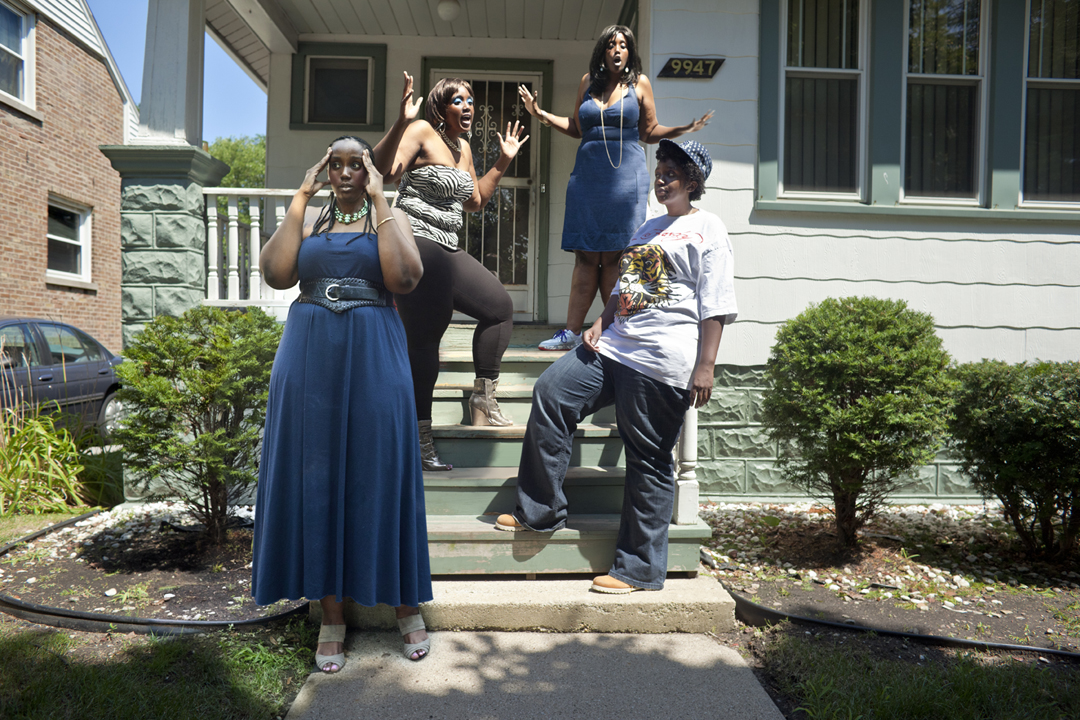Mainstream American culture reflects the beliefs, values, and practices of this country. There is a range of differences, however, bubbling just under the surface that provides an opportunity for immersion in the artistic style of various cultural traditions. African-American women continue to contribute to the distinction of a black aesthetic that is being cultivated through the works of independent artists throughout the art world. And local resident and visual artist Stephanie Graham is making her mark on this new era in art.

Graham explores themes reminiscent of African-American artists of the Harlem Renaissance presenting a representation of her culture that has not been whitewashed, but instead presents her voicing of political and social declarations through her art. Where artists from the 1920’s were influenced by the Great Depression and the Great Migration, Graham’s work is colored by #BlackLivesMatter and a divisive political climate.
Subcultures and Social Class
Graham articulates her struggles and hopes, however, in her own words and images providing a youthful perspective on age-old adages. As a result, her work is finding a wider audience and a broader voice. She’s most interested in making work about subcultures, social class, relationships and Black America. “I draw upon the stories of friends and strangers alike when creating staged imagery for my photography and video projects,” says the artist. Her work, which often examines complex topics such as race and gender, is delivered with a unique sense of humor providing a more comfortable option for consumption. “When you add humor to something, it makes it easier to talk about.”
Graham is a Set Dec Coordinator for “Chicago PD.” Her day-to-day schedule consists of working with budgets and researching set pieces for various scenes for the popular NBC television show. But she started her exploration of art and culture as a little girl from Schaumburg, a northwest suburb just outside Chicago’s city limits where although she had a number of friends, she didn’t have many Black friends.
Growing Up Black in the Burbs
Graham admits that she noticed she was a Black kid but it really didn’t bother her until somebody made fun of her because she was Black or if “at a pool party somebody got her hair wet.” Graham talks openly about how when she was growing up, she observed that Schaumburg was segregated by race and then the sub cultures. “There were the jocks, the goth kids, the Mexican kids that spoke English and the Mexican kids that didn’t speak English. Then there were the Black kids, the Black kids that hung out with the Hoffman Estate Black kids, and then there was me, Jane, and Justin.

The art world is in the midst of social, cultural, and intellectual disruption. Young artists are creating work that is an active demonstration of explicit social criticism based on personal experiences. Graham is unafraid of provoking controversy; as a result, her work embraces this disruption. “I can really relate to being the other. People who can relate to my work… they’ve been used to being the other. At my church, for example, our group was all the Black kids and then the gay kids…it was like if you were a minority, you were in this group. Then our teacher was a lesbian. I am always very perceptive of how people can feel alone. Our prom dates came from the city because the Black guys weren’t really talking to Black girls unless you were the Black girl that hung out with the White girls. Most of the Black guys were in interracial relationships.”
When Bill Clinton was Considered Cool
Graham’s piece Selected Black Experience Council was in response to her experiences of wanting to talk to someone about Black stuff as a young woman. With not very many Black people around, Graham would have to give certain non-Blacks a pass. It was around the time when “Bill Clinton was considered cool” by young Black people when Graham decided that she’d create a piece that represented an executive board designed to make decisions on who can talk about blackness.
SBEC would accept nominations for a black pass and if someone were awarded the recipient would get certain benefits. The performance part of the SBEC piece was presented at the Corner Gallery in the form of a board meeting. The council in this presentation of the SBEC was made up of whomever came to this board meeting. Ironically, the participants at that time where all non-Black.
Graham studied film at Columbia College Chicago.
“I went right after high school…you know you’re still trying to find out who you are. So, you really have to be strong to make it in film school.” Challenges she experienced were not unlike any other college student experience except that there were some specific challenges she faced that she believed where attributed to her being a woman.
She was sometimes unable to check out equipment because she was perceived as not having the skills to properly operate the camera. “Teacher’s played favorites over guys than girls…if I didn’t know how to light something, they’d say oh you did it wrong instead of taking the time to show why it’s wrong and fostering everybody’s ideas.”
Graham’s Work – Social Commentary without the Lens of Race or Gender
Although Graham doesn’t want her work to be viewed through a lens of race or gender, her pieces aren’t without social commentary on the matter and are often inspired by other African American artists. In 2015, Graham was invited to create a piece for the Terrain Biennial founded by Sabina Ott, who runs Terrain exhibitions in Oak Park. Terrain is an international exhibition of public art pieces and Graham’s foray into this area included a piece called Golden Kids.

In response to the unfortunate and untimely deaths caused by random shootings in the Chicago area, the Golden Kids installation was comprised of gold mirror cut out representations of Black and Brown children that allowed viewers to interact with the work itself and asked the question what happens to kids when they die when they weren’t ready to go. The playful gold-mirrored shapes invite people to look within themselves for answers. Graham was inspired by Kerry James Marshall’s Prospect 3 Biennial piece entitled Notes for Now and Flying Lotus’ (featuring Kendrick Lamar) music video for Never Catch Me.
Graham’s process philosophy supports collaboration across mediums. Writers, musicians, actors, sculptors, activists, philosophers…if she needs assistance in a skill area, she will work with another artist who can do the work. She wants to work smarter not harder. “My ideas come from listening to stories and being open to talking to people about anything without judgment.” This process allows for the building of cultural bridges or perhaps adds to the rebirth of social awareness that provokes more meaningful and genuine interactions between different types of people.

The Chicago Artist Coalition’s HATCH Project gave her exhibition opportunity. HATCH Projects is a Chicago Artist Coalition initiative. It is a competitive year-long incubator for contemporary artists and curators who work together to develop a professional exhibition. Graham applied two times and on the third try, she was accepted. It gave her a network of people with whom she could collaborate and put her into the “conversation of what she wanted to be.”
Jaxon Pallas, curator for the 2015 HATCH project, speaks sincerely about working with Graham. “It seems like all of the well traveled paths toward success are not the roads that she’s after. It’s like she really is out there with a machete sort of beating her own path and that’s really exciting to watch.”
Then there’s The Black Kid Table, which is a project featuring filmed vignettes of testimonials of the Black experience from various African-American perspectives. “Every year to keep me sharp, I do a February Facebook project where I do something around Black folks for February.” Past projects have included Favorite Black Best Friends in Media, Black Cowboys, and Black Women Married to Non-black Men.
“My project The Black Kid Table came from this. I’d like to do something around Black masculinity and friendship, but haven’t found male best friends just yet, so if someone is reading this and they want to talk to me about their best friend, I would love to speak to them.”
Historically there has been an immense gap in gallery representation and exhibition opportunities. However, Black artists refuse to continue battling for inclusion in the art world. Their great migration is forging new paths to visibility. Graham’s illustrated narratives depict a fresh new viewpoint merging history and culture with the activism of her life.
Graham’s work has been featured in Studio Photography Magazine and in the Chicago Alliance of African American Photographers’ The Journey Online Magazine, as well as Rolling Out Chicago. In 2008, Stephanie was featured as a “Chicago Artist to Watch” by the Chicago Artist Coalition and her work is also included in the permanent collection of The Chicago Historical Society. To contact the artist: www.missgraham.com